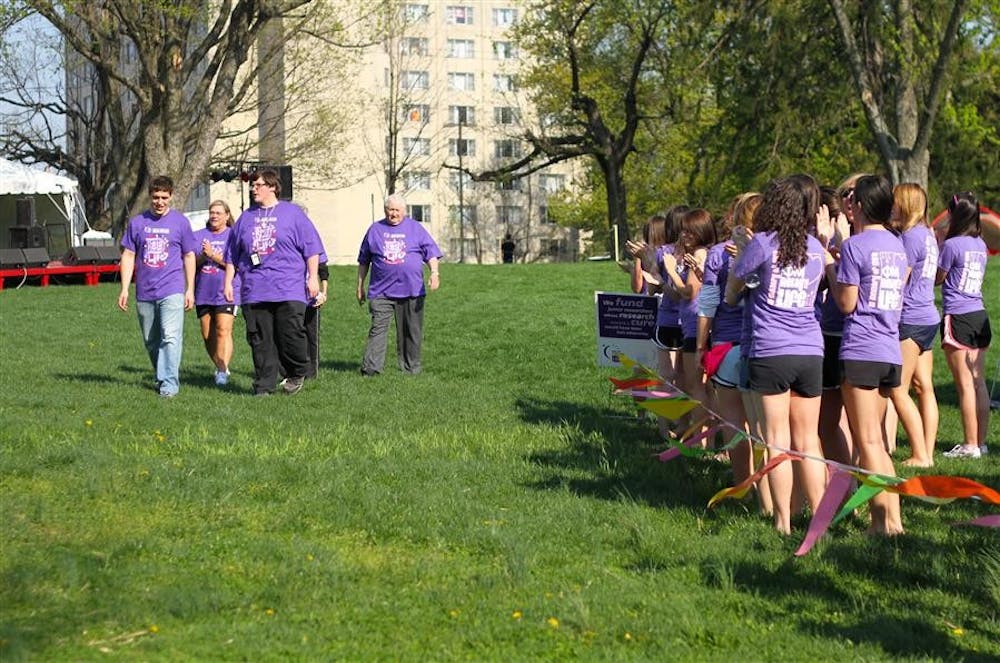The American Cancer Society’s Relay for Life organizers describe the relay as symbolic of one’s bout with cancer.
The first lap is full of anxious excitement: an uncertainty about the future, what will be endured and how it all will end.
Survivors led the first lap at IU’s Relay on Saturday. Wearing purple shirts that set them apart from the rest of the participants, each took the stage to celebrate how long they had been cancer-free.
Thirty-three teams comprised of between five and 70 people registered. All teams are required to have someone relaying at all times.
By nightfall, organizers said it seemed everyone knew what they were doing — as a cancer patient comes to understand radiation sessions, or the recovery process. It’s a routine. Even for the rookie participants.
Freshman Julianna McHale was at the relay with her sorority, Phi Mu. As other participants tried to sleep or took a break or took care of other commitments across campus, McHart said she was adamant not only in staying, but in staying awake for the whole thing.
“I’ve been inspired,” McHart said. “I owe it — out of respect, I think — to the survivors and the people battling cancer.”
A third of the way through the event, McHart said she had already walked 15 laps.
The relay is typically at the Hayes track, but because it is being resurfaced, organizers moved it to the DeVault Alumni Center on 17th Street. They said they liked the location better because it was more accessible and visible.
As relaying briefly stopped for the somber luminaria ceremony at sunset, so, too, did people walking and driving along 17th Street. Some cheered, some yelled, others just slowed down.
Senior and Event Development Chairwoman Cortney Frahm became involved in Relay after participating with her sorority during her freshman year.
She spoke during the luminaria ceremony, sharing the story of a vibrant young girl who finally lost her battle with cancer.
“There have been many people in my life who have inspired me to fight cancer, but no one has inspired me as much as her,” Frahm said. “She knew what was happening, and she wanted to fight cancer because that is the monster kids should be scared of.”
Following Frahm’s opening speech, each participant was presented with a glow stick and asked to crack it when their reason for relaying flashed across the screen: for a child, a friend, a family member.
Participants then took a silent lap around the track, observing all the luminarias set up in honor of cancer patients. Some snapped pictures, others held hands or hugged. Many cried.
And with that began the final stretch of the 15-hour relay.
Team Development Chairman Neil Black is a fifth-year senior.
He withdrew from school two years ago to focus all his attention on winning his own battle against cancer.
He said he participated in relays in high school but appreciates them more for the personal meaning they carry for him.
“Before I had cancer, I just thought it was a good cause,” Black said. “It’s very significant to me now. I had to get chemo and radiation, the whole nine yards. The event is just to get away from and manage the stress and worry associated with a cancer diagnosis.”
Organizers told participants they would feel exhausted and drained by the time the race was over.
But like a patient who has just battled cancer, there would be a sense of relief: of their having overcome something, of staying until the end, and of winning.
“A lot of people say you can relate Relay to cancer,” Frahm said. “You definitely don’t go through any of the hardships, but you feel those emotions. In the beginning you’re so excited, and by the end you’re dead tired, but you know did something good.”
Relay for Life symbolizes struggle

Get stories like this in your inbox
Subscribe





